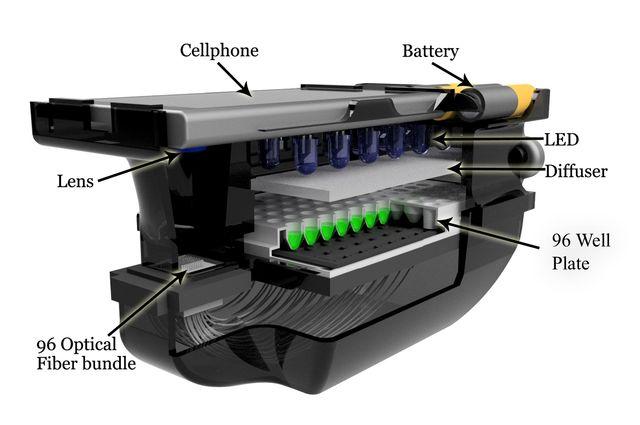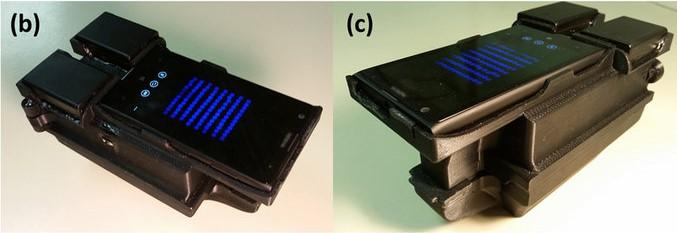A Smartphone with a 3D Printed Attachment Could Help Fight the Rise of Superbugs
 One of the most frightening threats to public health is one that has been growing for a long time: antimicrobial and antibiotic resistance. The evolving resistance of dangerous bacteria to antimicrobials has the potential to render some of our best defenses against infectious diseases ineffective, leaving us vulnerable to “superbugs” and pandemics. Experts have offered plenty of suggestions for preventing or at least slowing the development of drug-resistant bacteria: don’t prescribe antibiotics unless absolutely necessary, lay off the antibacterial soaps and sanitizers, and for heaven’s sake, stop feeding antibiotics to livestock.
One of the most frightening threats to public health is one that has been growing for a long time: antimicrobial and antibiotic resistance. The evolving resistance of dangerous bacteria to antimicrobials has the potential to render some of our best defenses against infectious diseases ineffective, leaving us vulnerable to “superbugs” and pandemics. Experts have offered plenty of suggestions for preventing or at least slowing the development of drug-resistant bacteria: don’t prescribe antibiotics unless absolutely necessary, lay off the antibacterial soaps and sanitizers, and for heaven’s sake, stop feeding antibiotics to livestock.
Or you could just use a smartphone. Not just any smartphone, to be fair – your Galaxy isn’t going to do you any good in warding off the plague. Researchers at UCLA, however, have come up with an ingenious device that uses an ordinary smartphone – with a few add-ons – to test antibiotic drugs for antimicrobial susceptibility in areas with limited or no access to resources such as labs, testing equipment and trained diagnostic technicians.
 The UCLA device uses a smartphone with a 3D printed attachment that can hold up to 96 wells for sample testing. The samples are illuminated by an array of LEDS, and the smartphone’s camera is used to sense small changes in the light transmission from the wells, which each hold a different sample dosage of antibiotic. The images are then sent to a connected server, which automatically performs antimicrobial susceptibility testing and sends the results back to the smartphone in about one minute.
The UCLA device uses a smartphone with a 3D printed attachment that can hold up to 96 wells for sample testing. The samples are illuminated by an array of LEDS, and the smartphone’s camera is used to sense small changes in the light transmission from the wells, which each hold a different sample dosage of antibiotic. The images are then sent to a connected server, which automatically performs antimicrobial susceptibility testing and sends the results back to the smartphone in about one minute.
“This work is extremely important and timely, given that drug-resistant bacteria are increasingly becoming a global threat rendering many of our first-line antibiotics ineffective,” said Aydogan Ozcan, Chancellor’s Professor of Electrical Engineering and Bioengineering at the UCLA Henry Samueli School of Engineering and Applied Science. “Our new smartphone-based technology can help put laboratory-quality testing into much wider adoption, especially in resource-limited regions.”
Ozcan and his research lab conducted the research in collaboration with two other UCLA professors and their labs: Omai Garner, an assistant professor of pathology and laboratory medicine in the Health Sciences department, and Dino Di Carlo, a professor of bioengineering. They tested the device in clinical settings by preparing plates with 17 different antibiotics designed to target Klebsiella pneumoniae, a bacterium with highly antimicrobial-resistant profiles. 78 bacteria samples were taken from patients, and the 3D printed smartphone device was able to detect resistance with 98.2% accuracy, meeting the FDA-defined criteria for laboratory testing.
Drug resistance is tracked by assigning a criterion that is either susceptible or resistant to antibiotics to sets of bacteria and antibiotic combinations, using the lowest concentration of antibiotic that prevented the growth of bacteria. A susceptible result indicates that an infected patient should respond to the antibiotic treatment, while a resistant organism will not respond to the concentrations of antibiotic used in a normal dosage. Physicians using the device could perform quick automated testing to assess treatment options for patients without needing expensive lab equipment or trained diagnosticians to interpret results.
“This mobile reader could eliminate the need for trained diagnosticians to perform antimicrobial susceptibility testing, reduce the cost barrier for routine testing, and assist in tracking of bacterial resistance globally,” Garner said.

The UCLA researchers designed a custom app for uploading well plates and analyzing and transmitting results
“An additional advantage of this technology is the possibility of examining bacterial growth in the presence of a drug at an earlier time point than is currently read, (about 24 hours),” added Di Carlo. “This could allow for a more rapid turnaround time of the results to the physician, which might help save lives.”
The results of the study have been published in an article entitled “High-throughput and automated diagnosis of antimicrobial resistance using a cost-effective cellphone-based micro-plate reader,” which you can read here. Additional authors of the study include Steve Feng and Derek Tseng, both research engineers in Ozcan’s lab. Discuss in the 3D Printed Smartphone Attachment forum at 3DPB.com.
[Source: UCLA]
Subscribe to Our Email Newsletter
Stay up-to-date on all the latest news from the 3D printing industry and receive information and offers from third party vendors.
Print Services
You May Also Like
New Business: Temporary, Migratory, & Modular 3D Printed Architecture
If we look at potentially emerging 3D printing businesses, then architecture has not been fully explored. Yes, there is a lot of house 3D printing going on worldwide. From deployable...
3D Printing News Briefs, April 19, 2025: Material Extrusion Standard, Metal Powder, & More
In today’s 3D Printing News Briefs, we’re covering a proposed standard for material extrusion, before moving on to business and metal powder. We’ll end with a commercial store’s robotic 3D...
Japan Unveils World’s First 3D Printed Train Station
Japan is now home to what we believe is the world’s first train station built with 3D printing technology. Located in Arida City, just south of Osaka, the new Hatsushima...
restor3d Raises $38M to Expand 3D Printed Orthopedic Implants
Backed by $38 million in new funding, restor3d is pushing ahead with the launch of four personalized implant lines, set to roll out in 2025 and 2026. This latest venture...


























